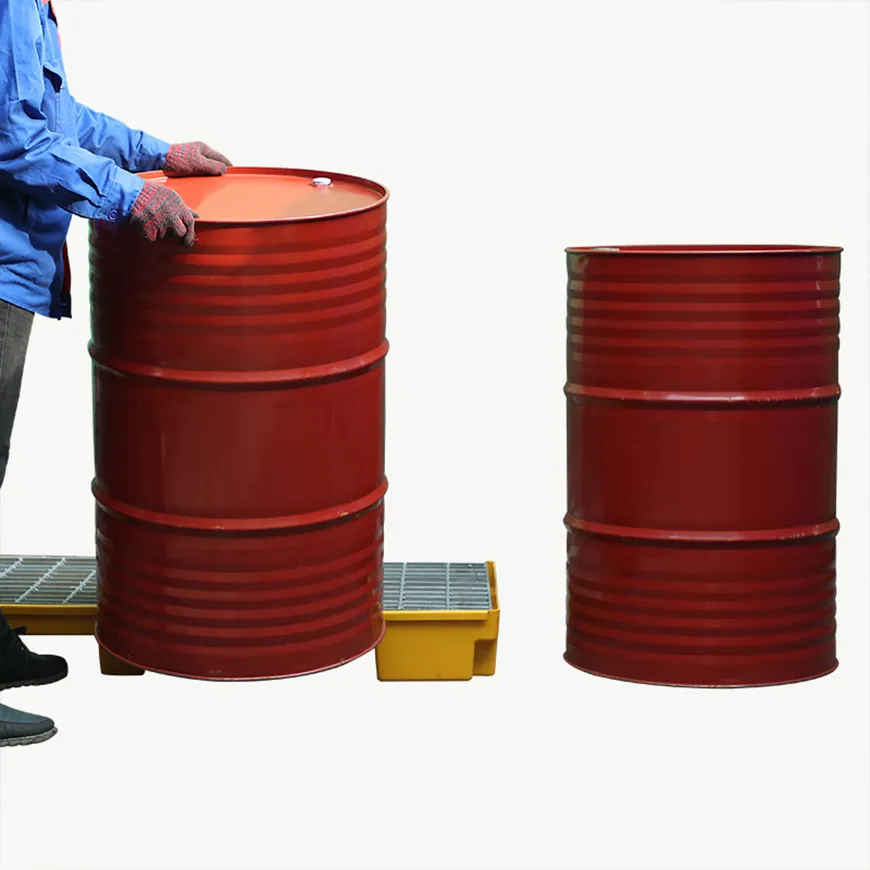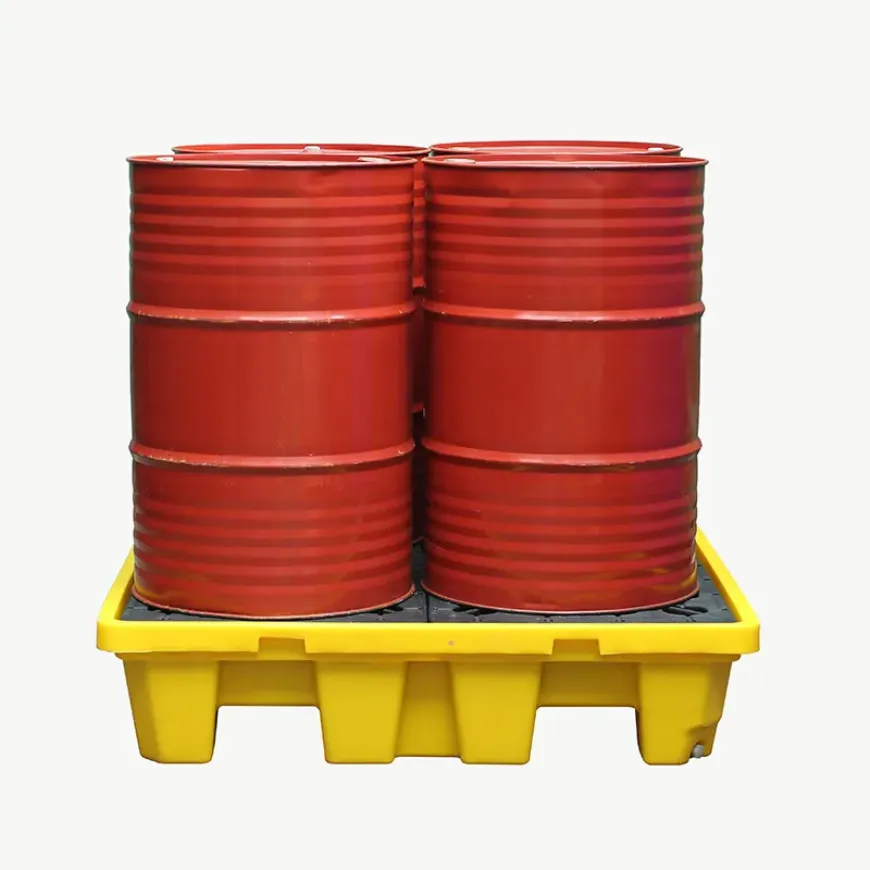
Keeping your workplace safe and compliant starts with choosing the right oil spill pallet. A high-quality spill containment pallet not only prevents spills but also helps you avoid costly fines from regulatory violations. Did you know compliant pallets meet EPA standards and reduce cleanup costs? Here’s a quick look:
Compliance Benefit | Cost Implication |
|---|---|
Avoid penalties from regulations | Reduces financial burdens from cleanup costs |
Meets EPA standards | Contributes to long-term savings |
By investing in solutions like Drum Spill Containment Pallets or IBC Spill Pallets, you ensure safety, efficiency, and long-term savings. Whether you’re managing oils, chemicals, or hazardous liquids, options like Containment Trays provide reliable protection.
Key Takeaways
Think about your workplace needs before picking a spill pallet. Check the type and amount of liquids you use to find the right size.
Pick between plastic and steel pallets based on your needs. Plastic is light and resists chemicals, while steel is strong for heavy items.
Follow EPA and OSHA rules to avoid fines and help the environment. Use pallets that meet safety and size rules.
Look for features like drains and easy movement in spill pallets. These make cleaning simple and help with changing workplace needs.
Buy good-quality spill pallets to save money over time. Strong pallets last longer and stop expensive spills.
Assessing Workplace Needs for Spill Containment
Choosing the right oil spill pallet starts with understanding your workplace’s specific needs. Let’s break it down step by step.
Type and Volume of Liquids
What kind of liquids do you handle daily? Oils, chemicals, or hazardous materials all require different levels of spill containment. The volume matters too. If you’re storing large quantities, you’ll need spill pallets with higher sump capacities. For instance, UPQUARK’s Drum Spill Containment Pallets offer options ranging from 42 liters to 1600 liters. This flexibility ensures you can manage anything from small leaks to significant spills. Always match the pallet’s capacity to the volume of liquids you store to avoid overflow risks.
Frequency of Spills
How often do spills happen in your workplace? If spills are frequent, you’ll need durable and easy-to-clean spill containment solutions. Look for features like drain plugs that simplify cleanup. For workplaces with occasional spills, a smaller spill kit might suffice. However, frequent spills may require a combination of spill kit types, such as utility trays for mixing chemicals or low-profile trays under shelving units. These tools help you stay prepared without disrupting daily operations.
Storage Space and Spill Kit Placement
Efficient placement of spill kits and pallets is crucial. Limited storage space? No problem. Use economical spill pallets for temporary drum storage or hardtop spill pallets for outdoor setups. Hardtop models with roll-top or swing-out doors provide easy access while protecting against weather. For larger spills, containment berms under tanker trucks or large containers work wonders. Low-profile trays fit neatly under shelves, capturing leaks without taking up extra room. Proper placement ensures your spill kits are always within reach when you need them most.
By assessing these factors, you’ll find the perfect spill containment solution for your workplace. Remember, the right tools and placement can save time, money, and stress.
Comparing Oil Spill Pallet Materials

When choosing the right spill containment pallet, the material plays a big role in its performance. Let’s explore the two most common materials—polyethylene and steel—and how they suit different needs.
Polyethylene Spill Containment Pallets
Polyethylene spill pallets are a popular choice for many workplaces. They’re lightweight, making them easy to move around, and they resist corrosion. This makes them perfect for handling a variety of chemicals, including oils and hazardous liquids. You’ll also find that polyethylene pallets are compatible with most chemical types, so they’re versatile for different applications.
However, they’re not ideal for every situation. While they’re durable, they don’t handle heavy impacts as well as steel pallets. If your workplace involves rough handling or heavy loads, you might need to consider other options.
Here’s a quick comparison to help you decide:
Material | Advantages | Disadvantages |
|---|---|---|
Polyethylene | Lightweight, resistant to corrosion, compatible with various chemicals | May not withstand heavy impacts as effectively as steel pallets |
Steel | Strong, durable, suitable for heavy loads and harsh conditions | Heavier and less chemically resistant than polyethylene pallets |
Steel Spill Containment Pallets
Steel spill pallets are built for strength and durability. They’re perfect for workplaces that deal with heavy loads or harsh conditions. If you’re storing water-polluting or flammable materials, steel pallets are often the go-to choice. They also provide excellent resistance to corrosion, especially in environments with corrosive substances.
These pallets are heavier than polyethylene ones, which can make them harder to move. However, their durability and ability to handle tough jobs make them worth considering for industrial applications.
Material Suitability for Specific Applications
So, how do you decide between polyethylene and steel? Think about your workplace needs. If you need a lightweight, chemical-resistant option for general use, polyethylene is a great fit. On the other hand, steel excels in demanding environments where strength and durability are key. For example, steel pallets are ideal for industries handling flammable liquids or heavy machinery.
By understanding the strengths of each material, you can choose a spill containment solution that meets your specific requirements. Whether you need lightweight flexibility or heavy-duty performance, there’s a material that fits your needs.
Ensuring Compliance with Safety and Environmental Standards

When it comes to spill containment, compliance with safety and environmental regulations is non-negotiable. Following these standards not only protects the environment but also keeps your workplace safe and avoids hefty fines. Let’s dive into the key regulations you need to know.
EPA and SPCC Requirements
The Environmental Protection Agency (EPA) and Spill Prevention, Control, and Countermeasure (SPCC) regulations set the foundation for spill containment systems. These rules ensure that spills don’t harm the environment. Here’s a quick breakdown:
Regulation | Requirement |
|---|---|
EPA 40 CFR 112 | Containment systems must hold 10% of the total volume or the largest container’s volume. |
RCRA | Secondary containment must meet the same capacity requirements as EPA 40 CFR 112. |
NPDES | Requires measures to prevent pollutants from entering U.S. waters, including a Stormwater Pollution Prevention Plan (SWPPP). |
For example, the Resource Conservation and Recovery Act (RCRA) ensures that even if a spill occurs, hazardous substances won’t harm the surrounding area. By using a compliant spill containment pallet, you can meet these requirements and protect your operations.
OSHA Standards for Spill Containment
The Occupational Safety and Health Administration (OSHA) also plays a big role in spill containment. Their standards focus on the safe handling of hazardous materials to protect workers and the environment. Here’s how these regulations influence spill containment pallet design:
Pallets must meet OSHA and EPA standards to avoid penalties.
They should have adequate capacity to handle spills, as outlined by RCRA.
Features like proper drainage and spill prevention mechanisms are essential for compliance.
By choosing pallets designed with these standards in mind, you ensure both safety and environmental protection.
Industry-Specific Guidelines
Different industries have unique needs when it comes to spill containment. For instance:
Chemical Plants: Must use secondary spill solutions like containment kits to minimize contamination risks.
Oil and Gas: Facilities often rely on industrial spill trays to manage spills from bulk storage.
Municipality and Utility Substations: Require containment for oil-filled equipment using specialized solutions like Wire Bracket Spill Containment BermPacs®.
Understanding these guidelines helps you select the right spill containment system for your industry. Whether you’re in manufacturing, energy, or utilities, compliance ensures smooth operations and environmental safety.
By staying compliant with these regulations, you not only protect the environment but also create a safer workplace. Plus, you avoid costly fines and maintain your reputation as a responsible business.
Key Features of an Effective Spill Containment Pallet

Size and Capacity Considerations
When choosing a spill containment pallet, size and capacity are two of the most important factors to consider. You need to think about the number of drums or containers you’ll store and the volume of liquids they hold. A pallet that’s too small might lead to overflow, while one that’s too large could waste valuable space. For example, UPQUARK’s spill pallets come in various sizes, accommodating anywhere from one to ten drums. This flexibility ensures you can find the right fit for your needs.
Also, consider the sump capacity of the pallet. It should meet or exceed regulatory requirements, such as holding 10% of the total stored liquid or the volume of the largest container. This ensures proper containment and protection against spills. By matching the pallet size and capacity to your workplace needs, you’ll create a safer and more efficient environment.
Drain Functionality and Cleanup Efficiency
Spills happen, but cleaning them up doesn’t have to be a hassle. That’s where drain functionality comes in. Spill containment pallets with built-in drain systems make cleanup faster and easier. These systems allow you to remove liquids quickly, reducing the risk of overflow and keeping your workspace tidy. This feature is especially useful in workplaces where spills are frequent. It saves time and effort, letting you focus on your operations instead of lengthy clean-up tasks.
Drain functionality also helps maintain the longevity of your spill containment system. By efficiently removing liquids, you prevent residue buildup that could damage the pallet over time. This makes it a practical feature for both daily use and long-term maintenance.
Portability and Modular Design
Portability and modular design are game-changers when it comes to spill control pallets. Portable pallets are easy to move, making them ideal for dynamic workplaces where storage needs change frequently. Modular designs, on the other hand, let you customize your spill containment system to fit your specific requirements. Whether you need to expand your setup or rearrange it, modular pallets offer unmatched flexibility.
Here’s a quick look at the benefits of these features:
Benefit | Description |
|---|---|
Platforms can be tailored to specific needs. | |
Scalability for growth | Can be expanded as business needs change. |
Easy assembly | Quick to set up and take down as required. |
These features make spill containment pallets versatile and adaptable, ensuring they meet your needs as your business evolves. Whether you’re dealing with small-scale operations or large industrial setups, portability and modularity provide the flexibility you need.
By focusing on these key features—size, capacity, drain functionality, and portability—you’ll find a spill containment pallet that’s both effective and efficient. The right choice will not only simplify cleanup but also enhance protection and compliance in your workplace.
Balancing Cost and Long-Term Value

Upfront Costs vs. Durability
When choosing spill pallets, upfront costs can vary depending on the material and design. While it might be tempting to go for the cheapest option, durability plays a huge role in long-term value. Let’s compare the two most common materials:
Material | Properties | Durability and Performance Impact |
|---|---|---|
Polyethylene | Lightweight, resistant to corrosion, compatible with various chemicals | Good for general use, effective in many environments |
Steel | Strong, durable, suitable for heavy loads and harsh conditions | Excellent for demanding applications and longevity |
Polyethylene pallets are great for general use and offer excellent chemical resistance. Steel pallets, on the other hand, are ideal for heavy-duty applications. While steel may cost more upfront, its durability can save you money in the long run. Think about your workplace needs and how often you’ll use the pallet to make the best choice.
Maintenance and Replacement Costs
Investing in high-quality spill containment units reduces the need for frequent replacements. Durable materials like polyethylene and steel withstand heavy use and harsh conditions, extending their lifespan. This means fewer maintenance expenses over time.
Here are some tips to keep costs low:
Regularly inspect your spill containment system for wear and tear.
Train your team on proper usage and placement to avoid unnecessary damage.
Use spill berms or other accessories to enhance protection and extend the life of your pallets.
By following these practices, you’ll minimize ongoing costs and ensure your spill control pallet stays reliable for years.
Long-Term Savings from Compliance and Safety
High-quality spill containment systems don’t just protect the environment—they also save you money. Here’s how:
Preventing spills and accidents reduces cleanup costs.
Avoiding regulatory fines keeps your financial resources intact.
Durable materials mean lower maintenance expenses over time.
Compliance with environmental standards ensures smooth operations and protects your reputation. Plus, investing in reliable spill containment features helps you avoid costly disruptions. Over time, these savings add up, making your initial investment well worth it.
By balancing upfront costs, maintenance, and long-term savings, you’ll find a spill containment solution that offers both value and peace of mind.
Choosing the right oil spill pallet boils down to a few key factors: understanding your workplace needs, selecting the right material, ensuring compliance, and considering features like size, capacity, and portability. Don’t forget to weigh upfront costs against long-term value. A well-chosen pallet protects your workers, reduces environmental risks, and keeps you compliant with regulations.
Spill containment pallets are essential for safely storing hazardous materials. They prevent spills, leaks, and drips, ensuring a safer and cleaner workspace.
To find the perfect solution, evaluate your specific requirements. Consider the type of liquids you handle, the space available, and your budget. UPQUARK’s Drum Spill Containment Pallets offer options for every need, from compact designs for small-scale operations to heavy-duty models for industrial use. With features like increased sump capacity and easy maintenance, these pallets deliver safety, compliance, and cost-effectiveness.
Invest in a high-quality spill containment solution today and protect your workplace for years to come.
FAQ
What is the purpose of a spill kit?
A spill kit helps you manage hazardous liquid spills quickly and effectively. It contains tools like absorbents, gloves, and disposal bags to ensure safe cleanup. Using a spill kit minimizes environmental risks and keeps your workplace compliant with safety regulations.
How do I choose the right spill kit sizes?
Consider the type and volume of liquids you handle. For small spills, compact kits work best. Larger operations may need industrial-sized kits. Always match the kit size to your workplace needs for effective spill containment and cleanup.
Where should I place spill kits in my workplace?
Strategic spill kit placement is key. Keep them near areas prone to spills, like storage rooms or workstations. Ensure they’re easily accessible during emergencies. Proper placement saves time and enhances protection against hazardous liquid spills.
How do spill containment units help with compliance?
Spill containment units meet regulatory requirements by preventing spills from spreading. They protect the environment and reduce cleanup costs. Using compliant products ensures your workplace avoids fines and stays safe for employees.
What are bunds and drip trays used for?
Bunds and drip trays capture leaks and drips from containers or machinery. They’re ideal for preventing small spills and maintaining a clean workspace. These tools complement larger spill containment systems for added environmental protection.
See Also
Selecting Ideal Universal Absorbent Socks for Your Work Environment
Evaluating UPQUARK Marine Absorbents for Effective Oil Spill Response

